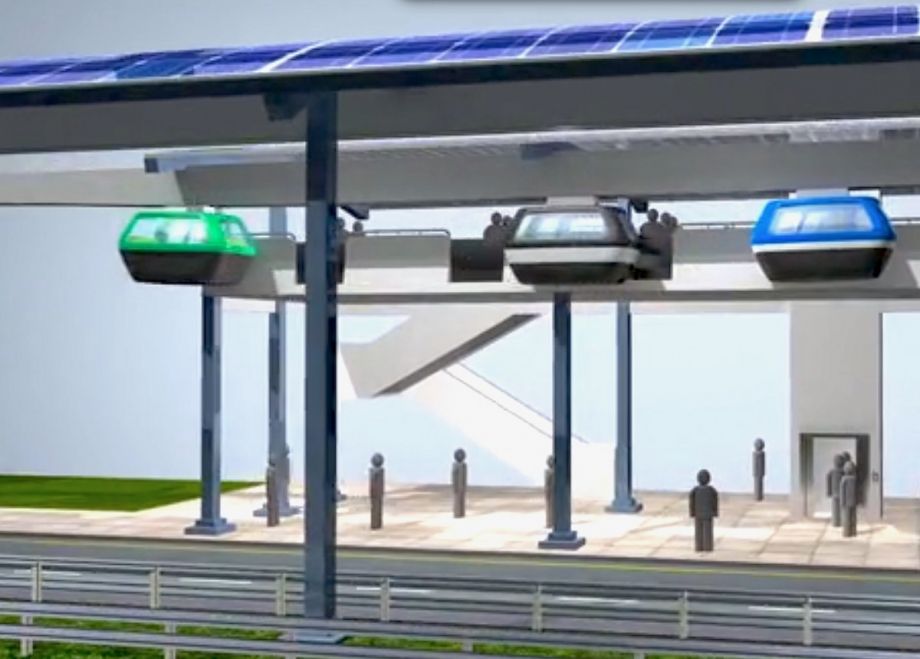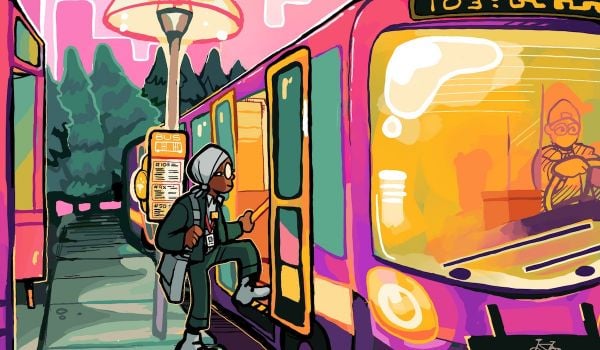Our weekly “New Starts” roundup of new and newsworthy transportation projects worldwide.
Could the Pod People Be Coming to Arlington?
The Columbia Pike streetcar in Arlington, Virginia, is dead, but that doesn’t mean that transit advocates have given up on getting some sort of rail service built in the corridor.
ARLnow reports that the Columbia Heights Civic Association will meet next month to discuss whether a personal rapid transit (PRT) technology called JPods might be a suitable alternative for Columbia Pike corridor residents.
The JPod technology employs small programmable vehicles that operate much like gondola cars suspended from an overhead guideway. Stations are located on sidings; passengers — six to eight per car — would enter their destinations on boarding and the cars would take them there, bypassing other stations on the route. The system would be powered by solar panels mounted on the guideway and on station platform canopies.
JPods owner Bill James describes the system as “like a chauffeured car” and touts its low cost of construction. The JPods website states that it would cost $10 million on average to build one of its PRT systems, but no specific figures have been produced for the Columbia Pike project.
James touts his system not only as a low-cost, flexible alternative to fixed-rail transit derived from the Morgantown, West Virginia, people mover, but as a blow against what he describes as an illegal federal government monopoly on transportation infrastructure. This is probably not uppermost on the minds of the Columbia Pike residents interested in the technology, but getting around Arlington faster and more efficiently is.
An Arlington County official quoted in the report said the county has been made aware of the JPod technology and notes that the builder claims it can be built without public funding, but said that it was too early for the county to comment on it because it has received neither detailed technical information on the project nor likely cost estimates. Arlington officials will not decide on an alternative transit plan for the Columbia Pike corridor until next year.
Nottingham LRT Extensions Open at Last
Two new lines that together double the size of the light-rail transit system in Nottingham, UK, finally opened for service on August 25th, eight months behind schedule.
According to an article in the International Railway Journal, the two lines add 17.5 km (10.9 miles) and 28 new stations to the system. Line 2 connects the city center with a park-and-ride garage in Clifton, while Line 3 branches off of Line 2 to serve Queen’s Medical Centre and the University of Nottingham (and ends at another park-and-ride).
The £570 million ($878.1 million U.S.) project was built by a consortium consisting of railcar builder Alstom, contractor Taylor Woodrow, financial partners Meridiam Infrastructure and OFI InfraVia Fund, and transit operators Keolis and Wellglade. The consortium received a 23-year contract to design, finance, build, operate and maintain the lines in December 2011.
The delays in completing the project were originally blamed on an unexpectedly large number of pipes and cables that needed to be moved and on the need to replace existing track structures. The delays produced a loss of £165 million ($254.2 million U.S.) for Vinci, one of the construction firms involved in the project.
Pittsburgh Pursues New Rubber-Tired Transitway
The City of Pittsburgh hopes to turn a huge lot on the banks of the Monongahela River into a new high-tech research, office and housing hub. The key to the transformation, Mayor Bill Peduto argues, is a new transitway connecting the site, now known as Almono, to the city’s university district in Oakland.
To make it happen, Pittsburgh’s Urban Redevelopment Authority (URA) is applying for a $3 million grant from the Commonwealth of Pennsylvania for the transitway’s first phase. A Pittsburgh Post-Gazette news story on the application states that if the grant is approved, work on the line could begin as early as June of next year.
Peduto first proposed this line in 2009, when he was a member of Pittsburgh City Council. At the time, he proposed converting a freight rail route into a light-rail transit line. Traffic on the freight line has increased to the point where this is no longer feasible, so the current proposal calls for the construction of a dedicated guideway for rubber-tired vehicles, possibly including autonomous driverless vehicles currently under development at Carnegie Mellon University.
The Almono site is the largest undeveloped parcel in Pittsburgh and had been the site of a coke plant for LTV Steel. The four foundations that own the site have drawn up plans that envision as many as 1,200 housing units and two million square feet of office and research space, but the site’s inaccessibility has so far kept those plans in abeyance. Kevin Acklin, chairman of the URA, told the Post-Gazette, “We think it’s a priority project for the city based on the present lack of a connection from Oakland to the Almono site. One of the challenges is to unlock that site from a transportation perspective and connect it to the rest of the community.”
There is strong demand for more research and office space in Oakland, but the vacancy rate for commercial space in the district is near zero, thus making the Almono project crucial for the continued growth of Pittsburgh’s high-tech research sector.
The project also includes bike and pedestrian improvements. The city’s grant application specifically mentions Carnegie Mellon’s work in developing autonomous vehicles as potentially benefitting from the new transitway and notes that it could be converted to a light-rail line at a later date.
Know of a project that should be featured in this column? Send a Tweet with links to @MarketStEl using the hashtag #newstarts.
The Works is made possible with the support of the Surdna Foundation.

Next City contributor Sandy Smith is the home and real estate editor at Philadelphia magazine. Over the years, his work has appeared in Hidden City Philadelphia, the Philadelphia Inquirer and other local and regional publications. His interest in cities stretches back to his youth in Kansas City, and his career in journalism and media relations extends back that far as well.
Follow Sandy .(JavaScript must be enabled to view this email address)

















